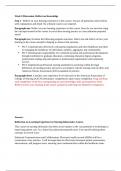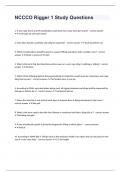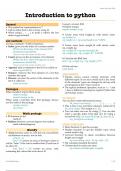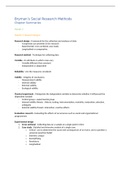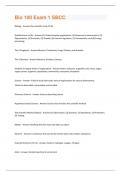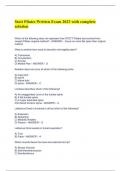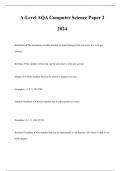Purchasing and Supply Chain
Management
Assignment A
Commercial Services Sector
,1. Introduction
Sustainable supply chain management can be defined as the management of material,
information and capital flows as well as cooperation among companies along the supply
chain while taking goals from all three dimensions of sustainable development, i.e.,
economic, environmental and social, into account which are derived from customer and
stakeholder requirements (Seuring, S. and Müller, M., 2008).
In sustainable supply chains, environmental and social criteria need to be fulfilled by the
members to remain within the supply chain, while it is expected that competitiveness would
be maintained through meeting customer needs and related economic criteria. This definition
is rather wide and combines those given for sustainability and supply chain management. It is
also able to integrate green/environmental supply chain management as one part of the wider
field (Seuring, S. and Müller, M., 2008).
The purpose of this report is to investigate different companies on these three perspectives of
sustainability, mentioned by Seuring & Müller. These perspectives are economics,
environment, and social. The companies that are being investigated are operating within two
subsectors of the commercial service sector.
1.1 Financial Services
Agricultural Bank (ABC) Of China is a Chinese bank that started in 1951. It is a state-owned
commercial bank. The bank is one of the biggest banks of China and has almost half a million
employees. It offers personal and corporate services (Abchina.com, 2019). ASN Bank is a
Dutch bank that was founded in 1960. The costumers are mainly personal account holders,
savers, and investors. All the years, the mission of the bank has been to create environmental
and social sustainability. The bank has around 175 employees (Asnbank.nl, 2019). BNP
Paribas S.A. is one of the largest banking groups in the world. It is established in France and
now has over 200,000 employees in 72 countries (BPN Paribas, 2019). BNP Paribas
organizes its businesses into two main fields of activity: Retail Banking & Services (RBS)
and Corporate Institutional Banking (CIB) (BPN Paribas, 2018). The Royal Bank of Scotland
was founded in Edinburgh in 1727. It went on to become one of the biggest banks in
Scotland. Today’s RBS and its brands are made up of hundreds of past banks. They were all
different – large and small, city and country, traditional and innovative – and grew to serve
the banking needs of unique communities all over the United Kingdom (Rbs.com, 2018).
1.2 Transportation sector
A.P. Møller-Mærsk Group (Mærsk) is a Danish integrated container logistic company. It goes
all the way for global trading for a growing world and got over 76.000 employees
(Maersk.com, 2018). American Airlines Group, formed in 2013, with the closing of the
merger between American Airlines and US Airways Group. Together with regional partner
American Eagle, they offer an average of almost 6,700 flights daily to 350 destinations in 50
countries (Aa.com, 2019). Deutsche Post DHL Group operates under two different brands:
DHL is uniquely positioned in the world’s growth markets, with a comprehensive range of
international express, freight transportation, e-commerce and supply chain management
, services. Deutsche Post is Europe’s leading postal service provider. The Group employs
around 550,000 employees in over 220 different countries worldwide (DPDHL, 2019). DSV
A/S is part of DSV - Global Transport and Logistics. The company started in 1976 in the
small town of Skuldelev in Denmark when ten owner-operated haulers joined forces and
founded DSV. Since then, DSV has evolved to become a world-leading supplier of transport
and logistics. DSV is organized into three divisions offering the complete range of services to
support their customers’ entire supply chain. These are transportation by air and sea (A/S),
transport by road (Road) and warehousing and logistics services (Solutions) (Dsv.com, 2019).
2. Method
The method for identifying the practices of the different companies is done by using
keywords based on the three perspectives of sustainability and GRI indicators. The Global
Reporting Initiative (GRI) is an independent, international organization dedicated to helping
businesses and governments report effectively and publicly disclose the impact of their
activities on key environmental, social, and governance (ESG) sustainability topics. This is
accomplished through GRI’s newest iteration of guidelines, simply called the Sustainability
Reporting Standards (GRI standards Reporting on sustainability issues that matter most,
2017). Because the main three GRI indicators are the same three perspectives (economic,
environmental, and social) as the three perspectives of sustainability, the GRI indicators are
very suitable to use as keywords.
Management
Assignment A
Commercial Services Sector
,1. Introduction
Sustainable supply chain management can be defined as the management of material,
information and capital flows as well as cooperation among companies along the supply
chain while taking goals from all three dimensions of sustainable development, i.e.,
economic, environmental and social, into account which are derived from customer and
stakeholder requirements (Seuring, S. and Müller, M., 2008).
In sustainable supply chains, environmental and social criteria need to be fulfilled by the
members to remain within the supply chain, while it is expected that competitiveness would
be maintained through meeting customer needs and related economic criteria. This definition
is rather wide and combines those given for sustainability and supply chain management. It is
also able to integrate green/environmental supply chain management as one part of the wider
field (Seuring, S. and Müller, M., 2008).
The purpose of this report is to investigate different companies on these three perspectives of
sustainability, mentioned by Seuring & Müller. These perspectives are economics,
environment, and social. The companies that are being investigated are operating within two
subsectors of the commercial service sector.
1.1 Financial Services
Agricultural Bank (ABC) Of China is a Chinese bank that started in 1951. It is a state-owned
commercial bank. The bank is one of the biggest banks of China and has almost half a million
employees. It offers personal and corporate services (Abchina.com, 2019). ASN Bank is a
Dutch bank that was founded in 1960. The costumers are mainly personal account holders,
savers, and investors. All the years, the mission of the bank has been to create environmental
and social sustainability. The bank has around 175 employees (Asnbank.nl, 2019). BNP
Paribas S.A. is one of the largest banking groups in the world. It is established in France and
now has over 200,000 employees in 72 countries (BPN Paribas, 2019). BNP Paribas
organizes its businesses into two main fields of activity: Retail Banking & Services (RBS)
and Corporate Institutional Banking (CIB) (BPN Paribas, 2018). The Royal Bank of Scotland
was founded in Edinburgh in 1727. It went on to become one of the biggest banks in
Scotland. Today’s RBS and its brands are made up of hundreds of past banks. They were all
different – large and small, city and country, traditional and innovative – and grew to serve
the banking needs of unique communities all over the United Kingdom (Rbs.com, 2018).
1.2 Transportation sector
A.P. Møller-Mærsk Group (Mærsk) is a Danish integrated container logistic company. It goes
all the way for global trading for a growing world and got over 76.000 employees
(Maersk.com, 2018). American Airlines Group, formed in 2013, with the closing of the
merger between American Airlines and US Airways Group. Together with regional partner
American Eagle, they offer an average of almost 6,700 flights daily to 350 destinations in 50
countries (Aa.com, 2019). Deutsche Post DHL Group operates under two different brands:
DHL is uniquely positioned in the world’s growth markets, with a comprehensive range of
international express, freight transportation, e-commerce and supply chain management
, services. Deutsche Post is Europe’s leading postal service provider. The Group employs
around 550,000 employees in over 220 different countries worldwide (DPDHL, 2019). DSV
A/S is part of DSV - Global Transport and Logistics. The company started in 1976 in the
small town of Skuldelev in Denmark when ten owner-operated haulers joined forces and
founded DSV. Since then, DSV has evolved to become a world-leading supplier of transport
and logistics. DSV is organized into three divisions offering the complete range of services to
support their customers’ entire supply chain. These are transportation by air and sea (A/S),
transport by road (Road) and warehousing and logistics services (Solutions) (Dsv.com, 2019).
2. Method
The method for identifying the practices of the different companies is done by using
keywords based on the three perspectives of sustainability and GRI indicators. The Global
Reporting Initiative (GRI) is an independent, international organization dedicated to helping
businesses and governments report effectively and publicly disclose the impact of their
activities on key environmental, social, and governance (ESG) sustainability topics. This is
accomplished through GRI’s newest iteration of guidelines, simply called the Sustainability
Reporting Standards (GRI standards Reporting on sustainability issues that matter most,
2017). Because the main three GRI indicators are the same three perspectives (economic,
environmental, and social) as the three perspectives of sustainability, the GRI indicators are
very suitable to use as keywords.


